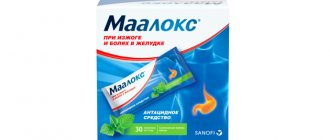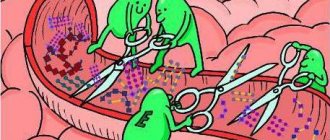Filtrum / FILTRUM NOT COAL
The main active ingredient of the anti-poisoning drug Filtrum® is lignin.
Lignin is a natural enterosorbent (also known as absorbent, adsorbent, sorbent) obtained from wood.
Due to the presence of micro-, meso- and macropores in its structure, lignin has a wide range of sorption activity. Thus, it has a pronounced ability to bind and remove from the body pathogenic bacteria and bacterial toxins, drugs, poisons, salts of heavy metals, alcohol, allergens, as well as an excess of certain metabolic products, including bilirubin, cholesterol, urea, metabolites responsible for the development of endogenous toxicosis.
The drug Filtrum® can be successfully used in the treatment of poisoning and diarrhea of various etiologies, even in cases where other drugs have not been effective:
| Causes/treatment | Antibiotics | Loperamide | Filtrum® |
| Intestinal infection caused by bacteria | + | May lead to complications. Can only be used as an adjuvant under medical supervision. | + |
| Rotavirus infection | Not effective | + | |
| Food poisoning | Not effective | + |
As research results* have shown, unlike activated carbon, the absorbent in case of poisoning does not cause inflammation of the mucous membrane of the stomach and intestines, does not have an abrasive effect, as a result of which it has improved physiological characteristics and can be used for long courses.
* Study of the effect of different sorbents on the condition of the mucous membrane of the gastrointestinal tract. Chikunova B.Z., Trubitsyna I.E., Novikov P.B. // Attending physician. 2008; 7:86–7
Activated carbon
Gastritis
Rice. 1. Inflammation of the gastric mucosa, magnification x250.
Eunit
Rice. 2. Inflammation of the small intestinal mucosa, magnification x120
Conclusions:
After 10 days of taking activated carbon, inflammatory changes are observed in the mucous membrane of the stomach and intestines.
Analogues of activated carbon: what can replace the drug?
From a medical point of view, sorbents are preparations for the absorption and removal of harmful substances from the body. In addition to the dosage form and dose, they differ in their mechanism of action. Based on the method of their influence on the toxin, there are 3 groups of medications:
- Adsorbents - bind a harmful component to form a solution or solid compound, after which it is removed through the excretory organs.
- Absorbents - they thicken a toxic substance, combine with it and are evacuated from the body.
- Ion exchangers absorb ions of harmful substances, replacing them with their own ions.
- Carbon is the main element in the structure of activated carbon, Ultrasorb, Sorbitol.
- Silicon is part of Polysorb, Atoxil, Enterosgel (these are mineral sorbents).
- Lignin (a polymer that is part of the structure of plant cells and algae) is the basis of Lactofiltrum, Lignosorb, Liferan, Polyphepan. They are organic sorbents.
- Chitin (a nitrogen-containing polysaccharide, a difficult-to-digest carbohydrate) is the basis of Chitosan.
- Aluminum-magnesium silicates are the active part of Smecta, Neosmectin, Almagel, Gastal.
- Peat is a component of Siala.
- Seaweed - forms Algisorb.
- Dietary fiber is a component of pectin and bran.
Medicines from the first two groups, due to a similar principle of action, belong to the same type of sorbents.
In addition, preparations similar to activated carbon differ in structure. Many varieties and names of sorbents with different chemical compositions have been created. They can be an effective replacement for coal. The properties of the substitute determine the spectrum of action, the rate of elimination of toxins, indications and contraindications for the use of sorbents.
There are several groups of sorbents depending on the main component in the chemical formula:
Filtrum®
Stomach
Rice. 3. Normal, magnification x120
Small intestine
Rice. 4. Normal, magnification x120
Conclusions:
After 10 days of taking the drug Filtrum®, no changes are observed in the mucous membrane of the stomach and intestines, the condition is within normal limits.
Organic
This group of sorbents is made from plant stems and coniferous trees; the active substance is hydrolytic lignin, which is capable of binding toxins to each other and removing them through natural pathways. Sometimes they contain pectin and similar compounds.
Polyphepan
Available in the form of black powder of wood origin, packaged in 10, 50 and 100 grams. The product stimulates peristalsis of the digestive tract, restores water-electrolyte and acid-base balance, increases the speed of metabolic processes and neutralizes poisons.
Indications for use are:
- chronic poisoning associated with the reproduction and spread of infection;
- drinking large amounts of alcohol;
- allergic reaction to food;
- postoperative complications caused by active inflammation;
- hangover syndrome.
The medicine is administered orally one hour before meals three times a day for a week. To cleanse the body, you need to dilute one dessert spoon with 100 ml of boiled water, stir well, and drink in one gulp.
Lignosorb
It comes in the form of granules, paste or powder for preparing a suspension. The medication binds toxins and promotes their elimination. Normalizes stool, improves the patient’s well-being.
Used for the following pathologies:
- dysbacteriosis;
- acute or chronic viral hepatitis;
- liver, kidney failure;
- drug overdose;
- angioedema;
- hives.
It is not recommended to use Lignosorb for constipation, intolerance to the active ingredient, or diabetes (glucose is present in the granules).
The dosage is selected individually, taking into account the course of the underlying disease, the age and weight of the patient.
Filtrum – STI
Release form: brown tablets, odorless and tasteless. According to the instructions, it is not absorbed from the digestive tract, is well absorbed and is completely excreted through the intestines within 24 hours.
Indications for admission are:
- acute intoxication with salts of heavy metals, alcoholic beverages;
- infectious diseases affecting the stomach and intestines;
- hyperbilirubinemia;
- allergy;
- purulent-inflammatory pathologies.
It is recommended to take 1-2 tablets three or four times a day before meals. If necessary, the volume of the active substance can be increased to 30 grams.
Polyfan
The sorbent is a powder for dilution, available in the form of bags containing 100 g of lignin derivatives: hydrocellulose and phenylpropane.
An analogue of activated carbon not only eliminates signs of poisoning, but also reduces the concentration of certain metabolic products: cholesterol, urea and bilirubin.
It is taken orally, the treatment regimen is determined by a specialist. Usually a teaspoon or dessert spoon of the substance is prescribed, which must be diluted in half a glass of clean water.
Entegnin
Used for various diseases caused by pathogenic microflora: dysentery, salmonellosis, viral hepatitis, cholera and others. It is also prescribed for severe allergic reactions, gestosis, liver and kidney failure.
Dosage form: granules, paste or powder for dilution. Has no taste or smell.
The medication is not recommended for persons suffering from anacid gastritis, diabetes mellitus, and constipation.
Another organic analogue of activated carbon, AG-3, is a Chinese development, which is used not for the treatment of poisoning, but for the purification of liquid and gaseous media.
Differences between Filtrum and activated carbon
Enterosorbents, including the drug Filtrum, are used in the treatment of food poisoning and intoxications of various origins. Its characteristics differ in many ways from those of activated carbon.
| Properties | Activated carbon | Filtrum |
| Pore size, which determines sorption (cleaning) ability | Large | Smaller, therefore sorption activity is much higher than that of activated carbon |
| Active surface | 1.5 sq.m/g | 16-20 sq.m/g |
| Required dosage | It is necessary to calculate the dose depending on body weight, especially for children | The required dose of the drug can be easily determined based only on the patient’s age |
| Effective amount of drug | It is necessary to take a large number of tablets at the same time/td> | Less number of tablets per dose |
| Abrasive damaging effect on the mucous membrane of the digestive organs | Eat | No |
| Development of microsigns of intestinal inflammation after intake | Eat | No |
| Need to crush before use | Eat | Not required |
| Package | Paper reams that can get wet | Waterproof foil blisters packed in a compact box |
| Differences in Side Effects | Long-term use may irritate the intestinal wall and cause loose stools. | Does not cause diarrhea |
| The likelihood of adsorption along with toxins of beneficial substances, for example, vitamins supplied with food | Relatively high | Relatively low |
| Efficacy in purulent-inflammatory diseases accompanied by endogenous intoxication | No | Eat |
| Efficacy in liver and kidney failure | No | Eat |
| Effectiveness against ethanol poisoning | Low | High |
| Possibility of taking it for the prevention of intoxication among workers in hazardous industries | No | Eat |
Thus, Filtrum is a more effective and safe drug from the group of enterosorbents compared to activated carbon. The possibilities for its use in cases of intoxication and poisoning are wider, and the number of side effects is less. In addition, Filtrum is more convenient to store and take.
Enterosorbents: clinical features and comparative table
Enterosorbents are a simple group of drugs with sorption and detoxification properties, which determine their widespread use in various conditions:
- poisoning (food, alcohol, drugs, heavy metal intoxication)
- intestinal infections
- endogenous intoxications: acute respiratory viral infections, acute respiratory infections, allergic reactions, dermatitis, helminthic infestations, liver and kidney failure, pancreatitis, etc.
Each sorbent has its own biophysical and clinical characteristics; let’s remember the main ones so that the choice of sorbent for the patient best suits the objectives.
Sorbents:
- Activated carbon
- Hydrolytic lignin
- Dioctahedral smectite
- Polymethylsiloxane polyhydrate
- Povidone
- Silicon dioxide colloidal
Two main characteristics of enterosorbents that allow us to judge their “performance” are sorption capacity and selectivity.
Sorption capacity (mol/g, mg/g) is the “power” of the enterosorbent. Shows how much substance (adsorbate) the sorbent can absorb per unit of its mass. The sorption capacity depends on the nature of the sorbate, as well as on the active surface area of the sorbent. The larger the absorption surface, the higher the sorption capacity.
Selectivity lies in the ability to sorption of particles of certain sizes, as well as microorganisms. Non-selective enterosorbent absorbs everything in the gastrointestinal tract: not only harmful substances, but also vitamins, mineral salts and other beneficial substances, as well as enzymes (pepsin, trypsin, amylase). Selective enterosorbents are able to absorb particles of certain sizes without affecting the absorption of substances beneficial to the body.
Enterosorbents also differ in their effect on the gastrointestinal mucosa.
Brief characteristics and features of the most famous sorbenets
Activated carbon
Examples of TN: Activated carbon, Carbopect, Sorbex, Ultra-adsorb, EXTRASORB
Coal has a large active surface area, is very popular and widely used due to its cheapness and “time-tested” nature. With prolonged use, it can cause constipation syndrome (constipation), intestinal atony, and irritate the gastrointestinal tract (abrasive effect). It is of great importance as an emergency enteral detoxification (gastric lavage with a charcoal suspension) in case of poisoning with medications (glycosides, barbiturates, sleeping pills, narcotics), household chemicals, and various poisons. When saturated, it tends to release bound substances back into the gastrointestinal tract. To avoid desorption and reabsorption of the bound substance, excess doses of activated carbon are necessary. It is also important to monitor timely bowel movements. Sorbs bacteria, gases, heavy metal salts. Weakly adsorbs proteins, acids, alkalis, methanol.
In what cases is it preferable: in case of acute poisoning with drugs, household chemicals, unidentified substances, in the first 2 hours, preference is given to carbon sorbents, in case of increased gas formation.
Cons: irritates the gastrointestinal tract, can cause intestinal atony, constipation. Before use, it is better to grind the tablets into powder.
Hydrolytic lignin
Examples of TN: Polyphepan, Filtrum-STI, Laktofiltrum, Polifan
Used quite rarely. Compensates for the lack of natural dietary fiber in human food, positively influencing the microflora of the large intestine and nonspecific immunity (1). Hydrophilic, absorbs water well. Capable of binding various microorganisms and their metabolic products. Effective against acute intestinal viral (including rotavirus) and bacterial infections, in particular, effective against Escherichia coli (2, 3). Lignin powder can be used externally in the treatment of purulent wounds, trophic ulcers and burns. Just like with coal, desorption of previously bound substances can occur.
In what cases is it preferable: first aid for acute poisoning with drugs, alkaloids, salts of heavy metals and other poisons; viral and bacterial intestinal infections accompanied by diarrhea.
Disadvantages: it is not advisable to use during exacerbation of peptic ulcer disease.
Hydrolyzed lignin + lactulose
Lactofiltrum
Combined preparation of lignin and lactulose. Lactulose is a substrate for the growth of beneficial intestinal bifidobacteria and lactobacteria, therefore Lactofiltrum is positioned as a drug for improving intestinal microflora and combating dysbiosis. It has a laxative effect, therefore it eliminates the side effect of lignin such as constipation. Lactulose is effective in preventing hepatic encephalopathy, which is associated with intoxication caused by dysfunction of the intestinal microflora.
In which cases is it preferable: disorders of the intestinal microflora during intestinal infections, incl. after antibiotic therapy; complex treatment of IBS (irritable bowel syndrome); hepatitis and cirrhosis of the liver (in complex treatment); allergic diseases.
Disadvantages: in case of exacerbation of gastric and duodenal ulcers, use caution.
Povidone
Examples of TN: SORBI-DETOX, Enterodes
It is in low demand in pharmacies due to being replaced by more popular broad-spectrum enterosorbents. Has pronounced detoxifying properties. Forms soluble or water-dispersible complexes with many substances, as a result of which the latter lose their toxicity. Increases renal blood flow, increases glomerular filtration, and enhances diuresis. Does not absorb bacteria and viruses. Indicated for toxic forms of acute intestinal infections. And also for liver and kidney failure. The finished solution has a specific smell. You can dilute with fruit juices or add sugar.
In what cases is it preferable: toxic forms of gastrointestinal infections; liver and kidney failure.
Cons: does not absorb bacteria and viruses. May cause nausea and vomiting at the beginning of use.
Polymethylsiloxane polyhydrate
Examples of TN: Enterosgel, Enteroactin, Enterodesgel
Selectively collects bacteria and their toxins, allergens, medications and poisons, heavy metal salts, radionuclides, alcohol. It also absorbs excess metabolic products: bilirubin, urea, cholesterol. Does not reduce the absorption of vitamins and microelements, has a positive effect on microflora, does not affect intestinal motor function, and has a cytoprotective effect for the gastrointestinal mucosa. Optimal for chronic diseases for long-term use.
In what cases is it preferable: in all cases where long-term use is necessary: toxicosis of pregnant women, in complex therapy of chronic allergic diseases; prevention and treatment of intoxications during chemotherapy (does not irritate the gastrointestinal tract, has a cytoprotective effect on the mucous membrane); prevention of chronic occupational intoxication; enterosorbent of choice in the presence of gastric and duodenal ulcers.
Cons: rejection when taken
Dioctahedral smectite
Examples of TN: Smecta, Neosmectin, Diosmectite, Endosorb, Dioctahedral Smectite, Dioctab Solution Tablets
Antidiarrheal effect with sorption properties. Stabilizes the mucous barrier of the gastrointestinal tract, has an enveloping effect and cytoprotective properties. Selectively sorbs enterotoxins, viruses and bacteria. Experiments have established the adsorbing properties of Smecta against gram-negative microorganisms and their toxins (Echerichii coli, Vibrio cholerae, Campylobacter jejuni, Clostridium difficile), as well as rotavirus (4). It has an antacid and proteolytic effect. An important property of smectite is the ability to neutralize enterotoxins A and B of Clostridium difficile, which makes it possible to use the drug for the prevention and treatment of antibiotic-associated diarrhea in children. The drug promotes the growth of saccharolytic and suppression of pathogenic proteolytic intestinal microflora. Children can mix it with porridge, compote, and milk mixture.
In which cases is it preferable: diarrhea of any origin, especially for young children due to ease of use; heartburn, bloating, discomfort in diseases of the gastrointestinal tract, in particular gastritis, gastric ulcer and duodenal ulcer.
Disadvantages: in case of overdose, severe constipation or bezoar, use with caution if there is a history of chronic constipation
Silicon dioxide colloidal
Examples of TN: Polysorb MP, PROSTOSORB
Sorbs bacteria and their toxins, allergens, drugs and poisons, heavy metal salts, radionuclides, alcohol. Also takes on bilirubin, urea, cholesterol. Indications for use are wide: various acute and chronic intoxications, diarrhea, purulent-septic diseases, various types of allergies, hyperbilirubinemia (hepatitis), hyperazotemia (chronic renal failure). It has an increased sorption capacity for proteins, so in conditions accompanied by the release of protein toxins (bacterial infections, allergies, burns) this is the preferred choice.
In what cases is it preferable: intoxication with bacterial toxins; food poisoning; purulent-septic diseases, burn disease, accompanied by intoxication; allergies.
Disadvantages: it absorbs low molecular weight compounds worse (compared to coal). Effect of persorption of Herbst-Volkheimer particles.
Do you have a favorite sorbent? Tell us which one and why!
You can discuss the latest news with all your Russian colleagues in chats:
- WhatsApp: https://chat.whatsapp.com/Izj3ZQ7aI36KK8e2dCjcm4
- Telegram: https://tglink.ru/joinchat/GWBPCkkLipQUnTbXrKqzGA
- VKontakte: https://vk.me/join/AJQ1dzabQRfHvl5Y2AOVUsgJ
Mineral
Sorbents contain silicon dioxide; this substance, due to its structure and chemical characteristics, adsorbs alkaloids and toxins well.
Enterosgel
One of the most popular drugs used for poisoning of various etiologies. It is a homogeneous pasty mass of white color, tasteless and odorless. It is a good alternative to activated carbon and other plant sorbents.
According to pharmacological data, this analogue of coal has pronounced detoxifying properties and does not penetrate into the mucous membrane of the gastrointestinal tract, does not irritate or injure tissue, which helps to improve the well-being of the victim in a short period of time.
Indications for use include:
- acute, chronic intoxication;
- infections;
- purulent-septic pathologies;
- dysbacteriosis;
- hyperbilirubinemia;
- hyperazotemia.
Side effects may include nausea, constipation, and flatulence. Not prescribed if you are hypersensitive to the components of Enterosgel. To reduce intoxication, it is enough to consume the contents of one package for a single dose.
Atoxyl
This analogue of activated carbon is available in individual sachets, bottles and vials. It is a fourth generation sorbent; in addition to the antiallergic and detoxification effect, it has a wound healing effect.
The drug can be used externally in the formation of trophic ulcers, in case of burn lesions of the skin in order to neutralize the toxic products of enzymatic transformations formed during tissue necrosis.
Before using the activated carbon substitute, you need to open the bottle of powder, pour in 250 milliliters of clean boiled water to the mark, shake and drink in one gulp. The duration of treatment is determined by the doctor.
Contraindications for use include:
- stomach ulcer;
- erosive gastritis;
- individual intolerance to the components of the drug;
- child's age up to one year.
When combined with acetylsalicylic acid, antiseptics, niacin, it increases the effect of the listed drugs.
Polysorb MP
Release form: powder for dilution and oral administration. It is not broken down by pancreatic enzymes and is excreted unchanged.
In terms of action and indications, it is practically no different from Enterosgel. Not used when diagnosing a patient with ulcerative and erosive lesions of the mucous membrane of the digestive tract, intestinal atony, and chronic constipation. In long-term therapy with Polysorb, the formation of hypovitaminosis and a decrease in the concentration of calcium in the blood is possible.
The daily dose for adults is 6–12 g; for children, the calculation is carried out individually, the details are described in the table.
| Body weight in kilograms | Volume of product (tsp) | Amount of water, ml |
| to 10 | 0,5 | 30–50 |
| 11–20 | 1, without slide | 30–50 |
| 21–30 | 1 | 50–70 |
| 31–40 | 2 | 70–100 |
| 41–60 | 3 | 100 |
| more than 60 | 3–4 | 100–150 |
One teaspoon of powder corresponds to 1 gram of medicinal substance.
Other types
A good replacement for activated carbon are preparations based on attapulgite, a mineral representative of the silicate group. Organic absorbents are prescribed much less frequently, however, these analogues have a pronounced antidiarrheal and antiallergenic effect.
Reaban
It is a film-coated tablet. It is most often used as part of combination therapy for stool disorders due to toxic infection. The exception is parasitic dysentery, in which this medication is contraindicated.
Reaban is drunk immediately after the first signs of poisoning appear; the maximum duration of treatment should not exceed two days. The dose is selected individually.
Neostopan (Neointestopan), Capect (Kaopectate)
Medicines are practically no different from the previous sorbent; they have the same indications, contraindications and side effects.
They are used orally, the initial dose for adults is 2.52 grams, for children from 6 to 12 years old - 1.26 g. The tablets must be swallowed whole, without chewing, with plenty of water.
Gelusil-varnish
The only analogue of coal from the proposed list that has a different mechanism of action. Its composition is similar to Almagel or Smecta, it includes magnesium and aluminum salts and minor components (sucrose, lactose, vanillin).
The drug is activated in the stomach, reduces acidity in the organ, coats the mucous membrane and neutralizes poisons. Does not affect the motility of the digestive tract.
Indications include:
- duodenitis;
- reflux esophagitis;
- severe pain in the abdominal area;
- heartburn;
- belching sour;
- gastritis;
- poisoning of unknown etiology;
- peptic ulcer.
Gelusil-lacquer should not be used during pregnancy, lactation and under the age of ten years.







